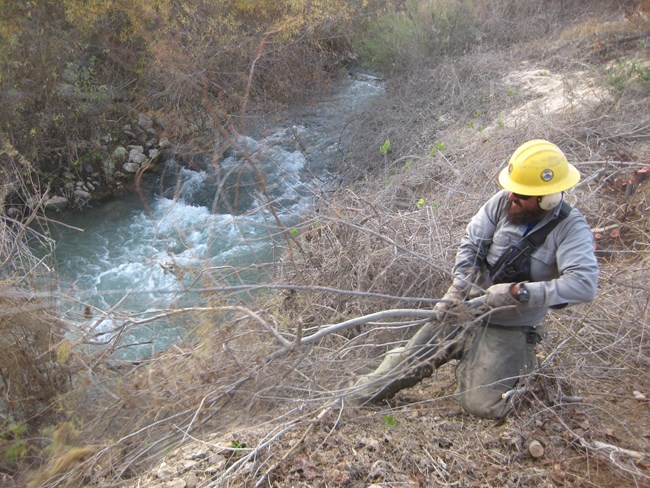
NPS Photo.
Who are the IPMTs?
One of the many ways the National Park Service (NPS) is combating invasive plants is through the Invasive Plant Management Team (IPMT) program, whose work provides support to approximately 290 national park units. For the past 22 years, teams have provided professional assistance directly to the parks, filling a much-needed gap in park expertise and assisting parks in preventing introductions of new species, reducing existing infestations, and restoring native plant communities and ecosystem functions.
The Biological Resources Division supports 15 IPMTs from coast to coast. Two more teams are funded through park base funding. IPMT liasons (team coordinators), IPMT data managers, IPMT field crew leaders, and IPMT field staff provide specialized scientific and technical assistance to and across all organizational levels of the NPS.
What do the IPMTs do?
Using multiple strategies, each team creates a work plan tailored to the needs of their partner parks, which may include:
- Cooperation and collaboration,
- Inventory and monitoring,
- Prevention,
- Early Detection and rapid response (EDRR)
- Treatment and control, and
- Restoration.
IPMTs work in a wide variety of ecosystems to target over 700 invasive plant species nationwide. The IPMT’s work in both urban and natural environments, ranging from park units within Washington DC to the Alaskan backcountry.
IPMTs By Region
Alaska Invasive Plant Management Team
Contact:
Anna O'Brien, liaison
Email us
North Coast-Casacades Network Invasive Plant Managment Team
Contact:
Gilbert Moreno
360-565-3076
e-mail us
Northern Rocky Mountain Invasive Plant Management Team
Contact:
Michael Reeves
970-903-8238
e-mail us
California Invasive Plant Management Team
Contact:
Steve Buckley, liaison
707-457-0001
e-mail us
Great Lakes Invasive Plant Management Team
Contact:
Isaiah Messerly, liaison
715-483-2299
e-mail us
Northern Great Plains Invasive Plant Management Team
Contact:
Ian Torrence
605-341-2801e-mail us
Heartland Network Invasive Plant Management Team
Contact:
Jordan Bell, project manager
417-732-6438 x400
e-mail us
Southwest Invasive Plant Management Team
Contact:
John Mack
303-969-2929
e-mail us
Lake Mead Invasive Plant Management Team
Contact:
Curt Deuser, liaison
702-293-8979
e-mail us
California Invasive Plant Management Team
Contact:
Steven Buckley, liaison
707-457-0001
e-mail us
Northern Rocky Mountain Invasive Plant Management Team
Contact:
John Mack
303-969-2929
e-mail us
Northeast Invasive Plant Management Team
Contact:
Emily Booth, liaison
570-832-3743
e-mail us
Mid-Atlantic Invasive Plant Management Team
Contact:
Emily Booth, liaison
570-832-3743
e-mail us
National Capitol Area Invasive Plant Management Team
Contact:
Alex Voznitza, liaison
202-339-8319
e-mail us
Southeast Invasive Plant Management Team
Contact:
Lauren Serra, liaison
803-695-0214
e-mail us
Florida and the Caribbean Invasive Plant Management Team
Contact:
Brian Lockwood, liaison
786-249-0073
e-mail us
Southeast Coast Invasive Plant Management Team
Contact:
Lauren Serra, liasion
803-695-0214
e-mail us
Gulf Coast Invasive Plant Management Team
Contact:
R. Dale McPherson, liaison
470-487-0974
e-mail us
Pacific Island Invasive Plant Management Team
Contact:
Jeremy Gooding, liason
808-281-1542
e-mail us
See how IPMTS are
Working to Help ParksAnnual Reports
More details about how the teams implement the above strategies can be found in the annual reports, accessed through the NPS database. Click on the dropdown box below to browse by year.
Source: NPS DataStore Collection 9169. To search for additional information, visit the NPS DataStore.
Last updated: November 18, 2025
